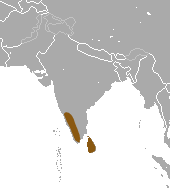Neck striped mongoose
| Neck striped mongoose | ||||||||||||
|---|---|---|---|---|---|---|---|---|---|---|---|---|

Neck striped mongoose ( Herpestes vitticollis ) |
||||||||||||
| Systematics | ||||||||||||
|
||||||||||||
| Scientific name | ||||||||||||
| Herpestes vitticollis | ||||||||||||
| Bennett , 1835 |
The stripe-necked mongoose ( Herpestes vitticollis ) is a predatory species from the family of mongooses (Herpestidae). It occurs in southern India and Sri Lanka . It owes its name to the striking dark neck stripes.
features
Neck striped mongoose are relatively large mongooses with characteristic, long outer hairs and a conspicuous, black neck strip on both sides of the body. When fully grown, they reach a head body length of around 50 cm and a tail length of around 30 cm. Animals from the Indian mainland are on average slightly larger than representatives from Sri Lanka. On the mainland, males weigh up to 3.4 kg, females up to 2.7 kg. In Sri Lanka, the maximum weights are 3.1 kg (males) and 1.7 kg (females). The head is iron gray to reddish brown, the front part is reddish yellow, mottled brown, the rear part is more orange-red. The underside is generally more yellowish, the feet, however, reddish brown, the tip of the tail is black. The dentition consists of 40 teeth.
Tooth formula:
Subspecies
There are two subspecies of the neck striped mongoose:
- H. v. vitticollis ( Bennett , 1835) - Southwest India and Sri Lanka
- H. v. inornatus ( Pocock , 1941) - Western India ( Karnataka )
distribution and habitat
The neck striped mongoose occurs in a very small distribution area in southwest India and on the island of Sri Lanka. The species inhabits evergreen and deciduous forests. They are also found in swampy areas and along rivers, as well as in plantations and bush areas. In Sri Lanka it also seems to colonize dry forests at lower elevations. The necked mongoose is rarely seen in the vicinity of settlements or in more intensely cultivated areas. In the mountains it has been proven up to an altitude of 2133 m.
The neck striped mongoose is still widespread in its rather limited range and is probably present in large numbers. It is also found in various protected areas. The species is therefore classified by the IUCN as not endangered (" Least Concern "). In India, it is less common in the northern parts of the range than in the south. It is most common here in Kerala , on the Nilgiri and Palani plateaus , as well as in the Meghamalai and Annamalai mountains . In Sri Lanka it still seems to be quite common in the mountain and hill countries. It is also not uncommon in the south in the area of the Menik Ganga River ( Moneragala District ) and in the Kalutara District . However, stocks in Sri Lanka in particular appear to be declining. In addition to the direct hunt for fur and meat, the neck striped mongoose is particularly threatened by habitat destruction.
Way of life

Little is known about the lifestyle and ecology of the necked mongoose. The animals seem to be mainly diurnal solitary animals. However, they sometimes appear in pairs. They feed on a variety of small mammals, birds, eggs, reptiles, insects and vegetable foods such as roots. Crustaceans, frogs and fish could also be part of the diet, as the animals are seen more often hunting in bodies of water. In addition, neck striped mongooses also eat the carrion of larger animals and have been observed eating sambar deer . Little is known about reproductive behavior. A litter presumably consists of two to three boys who are initially hidden in shelters like crevices in the rock.
Individual evidence
- ↑ a b c d e J. S. Gilchist, AP Jennings, G. Veron, & P. Cavallini (2009). Family Herpestidaae (Mongooses). In: Don E. Wilson, Russell A. Mittermeier (eds.): Handbook of the Mammals of the World. Volume 1: Carnivores. Lynx Edicions, 2009, ISBN 978-84-96553-49-1 , (p. 312).
- ↑ Herpestes vitticollis in the IUCN Red List of Threatened Species 2011.1. Posted by: Choudhury, A., Wozencraft, C., Muddapa, D. & Yonzon, P., 2008. Retrieved October 13, 2011.

